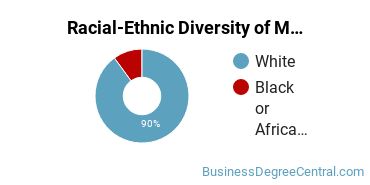Management Sciences & Quantitative Methods at Ferris State University
Every management sciences and quantitative methods school has its own distinct culture and strengths. We've pulled together some statistics and other details to help you see how the management science program at Ferris State University stacks up to those at other schools.Ferris is located in Big Rapids, Michigan and has a total student population of 11,165. Of the 493 students who graduated with a bachelor’s degree from Ferris State University in 2021, 11 of them were management sciences and quantitative methods majors.
Want to know more about the career opportunities in this field? Check out the Careers in Management Sciences & Quantitative Methods section at the bottom of this page.
Featured schools near , edit
Ferris Management Sciences & Quantitative Methods Degrees Available
- Bachelor’s Degree in Management Science
Ferris Management Sciences & Quantitative Methods Rankings
The following rankings from College Factual show how the management science progam at Ferris compares to programs at other colleges and universities.
Note: While rankings may be a good starting point when you're researching a school, they don't necessarily highlight all of a school's strengths. Don't forget to check out the other details that are available for a school to see if it has what you're looking for in a program.
Bachelor’s Degree Overall Quality & Other Notable Rankings
The management science major at Ferris is not ranked on College Factual’s Best Colleges and Universities for Management Sciences & Quantitative Methods. This could be for a number of reasons, such as not having enough data on the major or school to make an accurate assessment of its quality.
| Ranking Type | Rank |
|---|---|
| 38 | |
| 129 | |
| 195 | |
| 228 | |
| 372 |
Management Science Student Demographics at Ferris
Take a look at the following statistics related to the make-up of the management science majors at Ferris State University.
Ferris Management Sciences & Quantitative Methods Bachelor’s Program

About 73% of those who receive a bachelor's degree in management science at Ferris are white. This is above average for this degree on the nationwide level. Prospective students may be interested in knowing that this school graduates 3% more racial-ethnic minorities in its management science bachelor's program than the national average.*
The following table and chart show the race/ethnicity for students who recently graduated from Ferris State University with a bachelor's in management science.

| Race/Ethnicity | Number of Students |
|---|---|
| Asian | 1 |
| Black or African American | 0 |
| Hispanic or Latino | 2 |
| White | 8 |
| International Students | 0 |
| Other Races/Ethnicities | 0 |
Ferris also has a doctoral program available in management science. In 2021, 0 student graduated with a doctor's degree in this field.
Concentrations Within Management Sciences & Quantitative Methods
The following management science concentations are available at Ferris State University. The completion numbers here include all graduates who receive any type of degree in this field from Ferris State University. Some of these focus areas may not be available for your degree level.
| Concentration | Annual Degrees Awarded |
|---|---|
| Actuarial Science | 7 |
| Business Statistics | 4 |
Related Majors
- Insurance
- Human Resource Management
- Finance & Financial Management
- Specialized Sales, Merchandising & Marketing
- Hospitality Management
Careers That Management Science Grads May Go Into
A degree in management science can lead to the following careers. Since job numbers and average salaries can vary by geographic location, we have only included the numbers for MI, the home state for Ferris State University.
| Occupation | Jobs in MI | Average Salary in MI |
|---|---|---|
| General and Operations Managers | 58,140 | $122,160 |
| Chief Executives | 2,620 | $206,660 |
| Business Professors | 2,350 | $107,140 |
| Mathematical Science Professors | 1,730 | $85,970 |
| Operations Research Analysts | 1,640 | $88,820 |
References
*The racial-ethnic minorities count is calculated by taking the total number of students and subtracting white students, international students, and students whose race/ethnicity was unknown. This number is then divided by the total number of students at the school to obtain the racial-ethnic minorities percentage.
- College Factual
- National Center for Education Statistics
- O*NET Online
- Image Credit: By Michael Barera under License
More about our data sources and methodologies.
Featured Schools
You have goals. Southern New Hampshire University can help you get there. Whether you need a bachelor's degree to get into a career or want a master's degree to move up in your current career, SNHU has an online program for you. Find your degree from over 200 online programs.
Visit School
